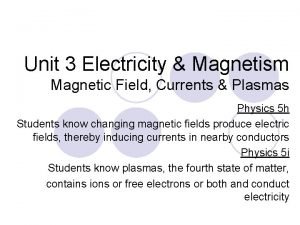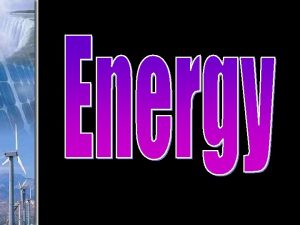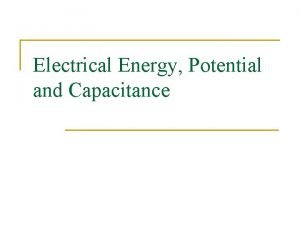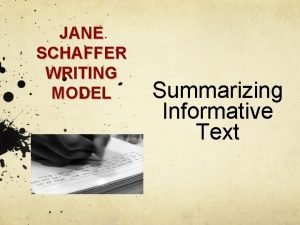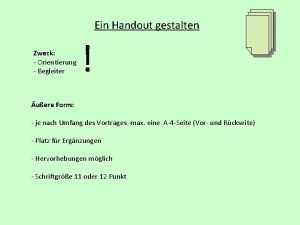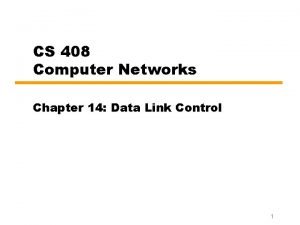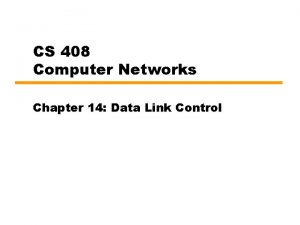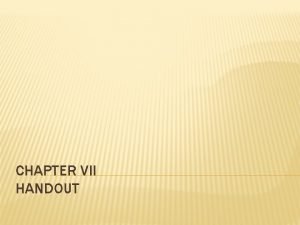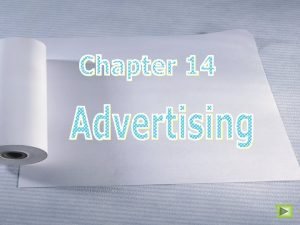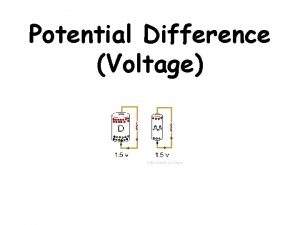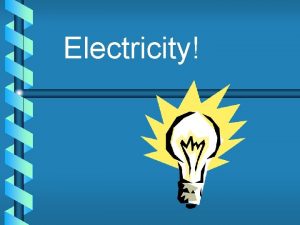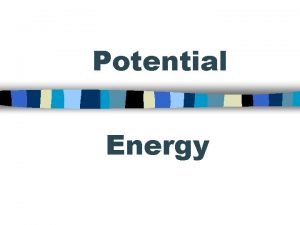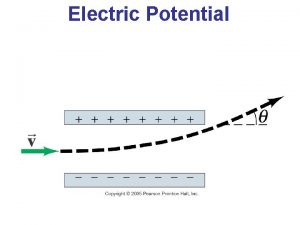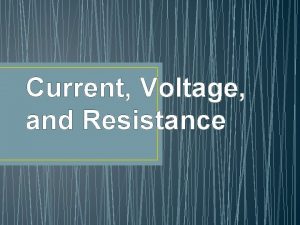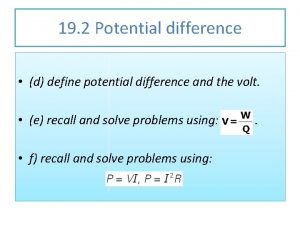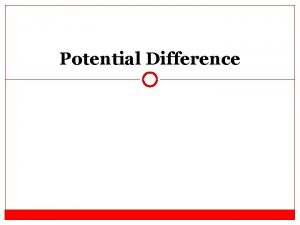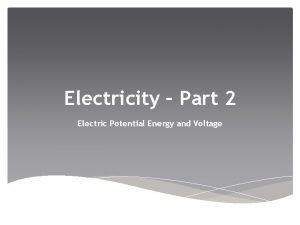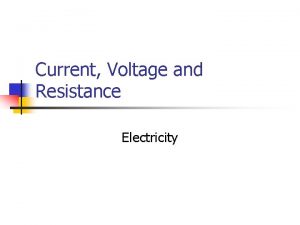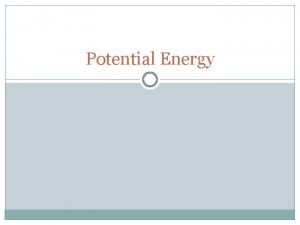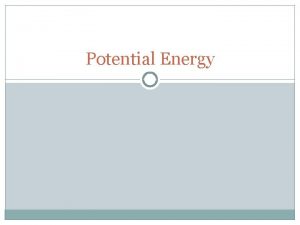Handouts Phones Up Electricity Potential difference voltage energy













































- Slides: 45

Handouts Phones Up

Electricity • Potential difference (voltage): (energy source)provides the “push” that makes the charges move around the circuit • Often a battery • Commonly referred to as voltage • This is analogous to gravitational potential energy. • For batteries, the positive and negative charges are separated. A negative charge next to a negative is a high potential (they want to separate)also known as energy source The unit for potential difference is VOLTS (V)

SIMPLE CIRCUIT – diagram a circuit with a potential difference, switch, resistor, and an ammeter.

Electricity • Circuits are usually drawn with a simplified diagram representing the power source or battery • The symbol used for potential difference (battery) in a circuit often looks like this:

Electricity • A circuit is simply a closed loop through which charges can continuously move.

Electricity • Closed circuit – the charges can flow from beginning to end • Open circuit – the charges cannot flow from beginning to end

Electricity • Resistor: (load) resists the flow of energy and converts electrical energy into another form of energy • E. g. , light bulbs convert electrical energy into heat and light.

Electricity • The symbol used for a resistor in a circuit often looks like this: • The unit for resistance / resistors is OHMS (Ω)

Conductor vs Insulator Conductor Insulator • Materials that impede the • Materials that permit free flow of electrons from electrons to flow freely atom to atom and from particle to particle molecule to molecule. • Transfers charge easily. • Does NOT transfer charge. REMEMBER! It is all about the electrons moving!!! PROTONS (positive charges) DO NOT MOVE!!!

Electricity • Wires –they connect the energy source and load. The charge flows through them. • Switch – opens and closes the circuit (turns it on and off)

Electricity • A wire in a circuit is simply a straight line: • A switch in a circuit typically looks like this:

Electricity • CURRENT: is the flow of charges. Current is measured in AMPERES, which we often shorten to AMPS (A). • Amps are measured by an ammeter. Often an ammeter is shown in a circuit diagram and looks like this: A

Starter Pg 92 -93 YOU NEED A CALCULATOR • What is a short circuit? • Give three examples of a resistor. • What is the unit for current? • What two parts of the light bulb must be touched in order for the light bulb to light up? • What is the symbol for a resistor? • What is the difference between a closed an open circuit?

Common Symbols

Series Circuit

Series Circuit • In a series circuit, all points of resistance are connected on the same current path. • Old strands of Christmas lights were series circuits for safety reasons. If one bulb burned out, the whole string of lights went dead. This limited the risk of a spark from a shorted-out point causing a tree fire, but frustrated people when they had to check every bulb in the strand to find one that needed replacement. • The current is the same across every point in a series circuit.

• A single charge passes through each resistor consecutively. • As resistors are added the current decreases • As resistors are added overall resistance increases • If one resistor (bulb) goes out all of the bulbs will go out

Equivalent Resistance • Equivalent resistance is the total amount of resistance in a circuit, which in series circuits is the sum of the resistance at every point across the circuit. • To calculate equivalent resistance in a series circuit, simply add the value of all the resistors together.

Parallel Circuit • In a parallel circuit, each resistor has its own complete path from the positive terminal to the negative terminal. • This means that if one bulb burns out on the string of lights, all the other bulbs stay lit. • In a parallel circuit, voltage remains the same across each point.

Parallel Circuit • Your house • Your phone • Your car

Parallel Circuit • A single charge passes through only one resistor • As resistors are added, current increases • As resistors are added , overall resistance decreases • If one resistor (bulb) goes out the remaining ones get brighter

Equivalent Resistance • To calculate equivalent resistance in a parallel circuit, add the inverse value of all the resistors together, and take the inverse of the sum.

Example #1 • Calculate the equivalent resistance in the series circuit shown below: • R = (R 1) + (R 2) + (R 3) + … • R = (3) + (10) + (5) • R = 18Ω

Example #2 • Calculate the equivalent resistance in the parallel circuit shown below (round to the nearest tenth): • • 1/R = (1/R 1) + (1/R 2) + (1/R 3) + … 1/R = (1/10) + (1/20) + (1/30) + (1/40) 1/R = (. 21) R = 4. 8 Ω

Example #3 • A circuit is connected to a battery, and current flows through resistors of 4Ω, 6Ω, and 10Ω. a) Draw the schematic representing this situation in a series circuit. b) Draw the schematic representing this situation in a parallel circuit. 4Ω 6Ω 10Ω 4Ω 6Ω 10 Ω

Examples #4 -5 • If R 1 = 3 Ω, R 2 = 5 Ω, & R 3 = 1 Ω, what is the equivalent resistance in the circuit? • Req = 3 + 5 + 1 = 9 Ω • If R 1 = 4 Ω, R 2 = 2 Ω, & R 3 = 2 Ω, what is the equivalent resistance in the circuit? • 1/Req = ¼ + ½ = 1. 25 • Req = 1/1. 25 = 0. 8 Ω

• https: //www. youtube. com/watch? v=4 th. VCsp. Af. K 4 • https: //www. youtube. com/watch? v=a 3 Ftc_2 iu 7 s&t=110 s • https: //www. youtube. co 6 m/watch? v=Je. Fy. JN 9 q. W 48 • https: //www. youtube. com/watch? v=0 j 0 w. UOt 9 PK 0

CALCULATOR TODAY!! Handouts Phones Up Starter pg 92 -93

Starter pg 92 -93 You need a calculator today • What is a series circuit? Define and give example. • What is a parallel circuit? Define and give example.

STARTER pg 92 -93 • Of the below batteries which one would not work in a circuit? Why? A. B. • Why does salt water work as a conductor while pure distilled water is an insulator? • What is the difference between a parallel and a series circuit?

Electricity Today we will: Show to calculate resistance, potential difference and power in a circuit using ohms law. Demonstrate how to use ohms law to solve word problems. Questions: How does energy flow through a system? How is electrical energy converted into other forms of energy?

Electricity

Electricity • OHM’s LAW – relates potential difference (V), current (I), and resistance (R): • Potential difference=volts • current=amps • Resistance=ohms

Electricity • Applying Ohm’s Law: If the resistor remains as is, what happens if I increase the potential difference (aka put a battery in the circuit with a higher voltage)? the current increases If the potential difference remains the same, but I decrease the value of the resistor, what happens? the current increases

Electricity • Low current vs High current

Electricity • What is the current measured by the ammeter? • I = V/R = 10/60 = 0. 167 A

Electricity • What is the potential difference in this circuit? • V=IR=(2)(30)=60 V

Electricity • What is the resistance in this circuit? • R=V/I=6/2=3Ω 6

Electrical Power Equation • P=VI • Power = Voltage X Current

AC/DC • Direct Current: a constant stream of electrons in one direction. • DC example: a battery • https: //www. youtube. com/watc h? v=5 UYF 23 C 2 Hew • Alternating Current: charges constantly reverse directions (60 times per second in the US) • AC example: 120 Volt wall outlet

Starter on front of Ohm’s worksheet 1. What is the power of an electric circuit running with 1. 2 amps and 5 volts? 2. What is the potential difference when a circuit has 2 watts of power and 4 amps of resistance? 3. A student creates a circuit with a current of 15 amps and a voltage of 50 v how much power will the circuit generate? 4. A circuit with 30 v and 12 watts of power, what is the current? 5. If the current increases in a circuit what will happen to the power generated?

You need a calculator today! Put your phone away Get out your homework and turn it in ASAP TRANSFORMERS Objective: Identify the different types of transformers. Review electrical energy and demonstrate understanding of electricity through a quiz.

https: //www. youtube. com/watch? v=w 9 ug. Mmr. CTg 0 • Transformers are composed of: iron core ring wrapped in coils • • One coil is connected to an AC input voltage and is called the primary coil (input). The other coil is connected to an output circuit with a load resistance and is called the secondary coil(output). • • The two coils are well insulated from each other and do not form a physical electrical connection. • • Transformers can either step up or step down a voltage. • • The constantly changing current induces a changing magnetic field in the core of the transformer. • • If there are fewer coil turns in the secondary than the primary, it is a step-down transformer (high voltage to low). • • Step-up is the opposite of step-down, it has fewer coil turns on input the than the output and changes the voltage from lower into higher.

Review • 1. What type of current is used to power your house? AC • 2. If a circuit has a current of 4 A and a power of 12 W, what is the potential difference? V=P/I 12/4=3 v • 3. What is the resistance of a circuit with a voltage of 9 v and a current of 7 A? R=V/I 9/7=1. 29Ω • 4. What is the equivalent resistance of a series circuit with resistors at 3Ω, 4 Ω, and 6 Ω? R = (R 1) + (R 2) + (R 3) 3+4+6=13Ω • 5. 4. What is the equivalent resistance of a parallel circuit with resistors at 3Ω, 4 Ω, and 6 Ω? 1/R = (1/R 1) + (1/R 2) + (1/R 3) 1/R = (1/3) + (1/4) + (1/6) 1/. 75=1. 33Ω

Electricity Circuit PROJECT
 Units of electric potential energy
Units of electric potential energy Difference between phase voltage and line voltage
Difference between phase voltage and line voltage Electrical potential energy
Electrical potential energy V=pe/q
V=pe/q Define electric potential and potential difference.
Define electric potential and potential difference. Sales potential vs market potential
Sales potential vs market potential Electric potential
Electric potential Potential of conductor
Potential of conductor What is electrical potential
What is electrical potential Static electricity and current electricity
Static electricity and current electricity Static electricity and current electricity
Static electricity and current electricity How are static electricity and current electricity alike
How are static electricity and current electricity alike Current magnet
Current magnet Introduction to high voltage technology
Introduction to high voltage technology Ac voltage controllers
Ac voltage controllers Convert rms voltage to dc voltage
Convert rms voltage to dc voltage Step voltage and touch voltage
Step voltage and touch voltage Electric energy formula
Electric energy formula Gravity
Gravity Chemical energy
Chemical energy Examples of mechanical energy at home
Examples of mechanical energy at home Gravitational potential energy vs kinetic energy
Gravitational potential energy vs kinetic energy The law of conservation of energy states that
The law of conservation of energy states that Elastic potential energy examples
Elastic potential energy examples Types of potential energy
Types of potential energy Mechanical advantage
Mechanical advantage Potential energy units
Potential energy units Whats the difference between kinetic and potential energy
Whats the difference between kinetic and potential energy Difference between potential difference and emf
Difference between potential difference and emf Zoo103 handouts pdf
Zoo103 handouts pdf How to write a schaffer paragraph
How to write a schaffer paragraph Sample of handouts
Sample of handouts Handout gestalten schule
Handout gestalten schule Cs408 handouts
Cs408 handouts Cs408 handouts
Cs408 handouts Definition of handouts
Definition of handouts Student handouts inc
Student handouts inc Student handouts.com
Student handouts.com Gapped handouts
Gapped handouts Advantages and disadvantages of handouts in teaching
Advantages and disadvantages of handouts in teaching Patient education template
Patient education template Advantages of broadcast advertising
Advantages of broadcast advertising Student handouts inc
Student handouts inc Why is water potential measured in pascals
Why is water potential measured in pascals How does water potential affect osmosis
How does water potential affect osmosis Solute potential equation
Solute potential equation












